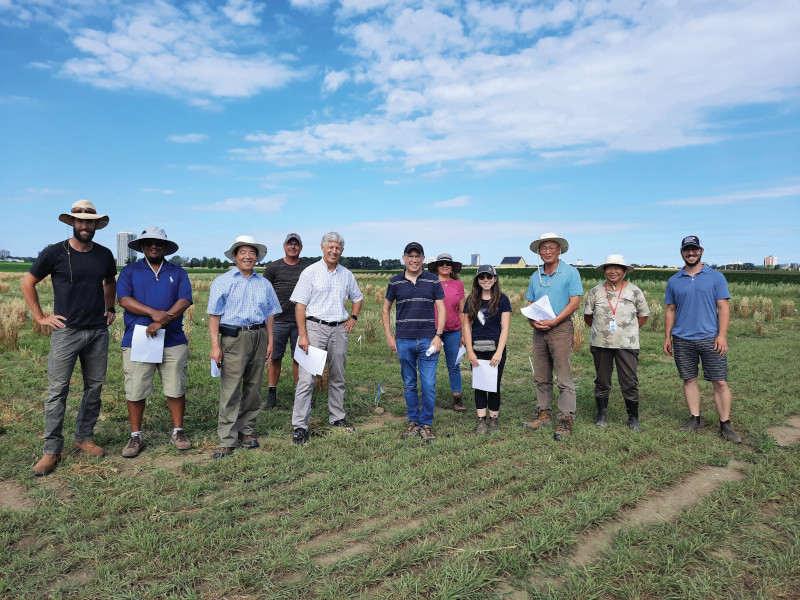
Conventional Breeding Continues to Advance Cereals
Hybrid cereals may be in the future, but Canadian breeders continue to offer farmers top-notch cereal varieties that deliver the quality characteristics to meet market demands.
Although there is a lot of buzz about the possibility of hybrid wheat and barley varieties being available in the future, conventional cereal breeding programs quietly continue to deliver increased yields, better disease resistance and the ability to maintain and build on the strength of the genetic advances that have been achieved to date.
“Many studies have been done in Europe, Australia, the United States and Canada and what you see over a long period of time is an average genetic gain of about one per cent of yield per year,” says Brian Rossnagel, a barley breeder at the University of Saskatchewan.
Huge strides have also been made in disease resistance and lower protein content in new malt barley varieties, such as CDC Meredith, Bentley and Merit 57. “Each of these varieties, when they are grown side by side with AC Metcalfe, consistently produce about a per cent less protein at a higher yield level,” says Rossnagel. “All these varieties are well over 10 per cent higher yielding than AC Metcalfe.”
Many higher yielding wheat varieties have been introduced over the past 10 to 15 years, but it is improved agronomic qualities, such as short straw to improve harvestability, as well as pest and disease resistance that, in many cases, has allowed them to achieve their full yield potential, says Robert Graf, a wheat breeder at AAFC’s Lethbridge Research Centre.
|
The Crop Molecular Genetics Laboratory supports the barley breeding program of the Crop Development Centre through both the development of and screening for molecular markers. |
“Within the last 10 years we’ve seen midge-resistant varieties come on stream in Western Canada,” he says. “Those varieties have substantially driven yields of our spring wheats. We’re seeing much more of a true reflection of some of the yield potential that we’ve been able to breed into those varieties. Compared to varieties that were registered, say, 15 years ago, in some cases, we’re seeing up to a 20 per cent yield advantage.”
There has also been continual progress made in fusarium head blight and rust resistance in wheat lines. Spring wheat varieties that offer moderate to intermediate resistance to FHB are now more common. “They are also higher yielding varieties as well, so we’ve been able to increase both yield and disease resistance at the same time,” says Graf.
That said, all wheat breeders remain vigilant to the possibility of new stripe, leaf and stem rust races, including Ug99, that evolve quickly and can potentially defeat some of the genes deployed against them. “Stripe rust is becoming more of a problem,” says Graf. “We have new, more virulent races in North America, so it’s very important to incorporate resistance into our varieties. In leaf rust we’re seeing some very good genes that have been defeated. A good example of that is Lr21, which conferred excellent resistance in many of our varieties over the past 10 to 15 years. We have other genes, but we constantly have to be looking for new resistance and pyramiding genes to try and make sure that the genes we have deployed will be useful over the long term.”
Another thing that can restrict potential yield is environmental conditions. “Most variability in yield comes from growing conditions,” says Rossnagel. “If we look at 2013, which was one of the best crop years in Western Canada, and compare the yields versus the long term average for all classes of wheat, barley, canola and so on, the average yield increase over normal ranges from about 28 per cent to 32 per cent in all three Prairie provinces. This data tells me that almost all this yield increase came from the environment. New genetics, equipment and technologies allowed the expression of that to happen, but it wasn’t all down to a specific variety or seeding equipment or micro-nutrient. It was all those things that did it in combination with a perfect storm of weather.”
Utilizing Technology
What has helped to make conventional breeding more efficient and cost-effective over the past 10 to 15 years has been the wider adoption of technology such as marker-assisted breeding and other “cross-overs” from the biotechnology field, such as the use of double haploidy, which can shorten the breeding process by producing genetically pure inbred lines in just one year.
“Canada has been at the forefront in utilizing doubled haploids in both spring and winter wheat breeding,” says Graf. “It speeds up the breeding process anywhere from two to four years, depending on access to winter nurseries and that kind of thing. DNA markers have also been a big plus. It doesn’t increase the speed as you develop a variety, but it does increase your efficiency by getting rid of some of the things that you definitely know you do not want, so you can go to the field with those lines that hopefully will have more of the characteristics that you’re looking for.”
In malt barley, breeding advances in both technology and equipment, particularly for quality evaluation and testing, have also been important.
“One of the other things that’s dramatically changed for us all is the ability to measure chemical constituents in samples cost-effectively, to be able to make improvements in things like beta-glucan content in food barley and food oats and cutting it down in malting barley,” says Rossnagel. “Ten years ago, we could measure beta-glucan in only a few samples because of the cost of the lab process, equipment and the staff needed to do it, but now we can do thousands of samples and the sample size is even smaller than it used to be.”
Near-infrared technology is also allowing breeders to screen for desirable qualities in the lab without having to destroy precious seed samples that are initially produced in small quantities at the early stages of the breeding process. Equipment changes include micro-malters, which allow malt barley breeders to use small batches and get good malting information from smaller samples.
“Canada has been at the forefront in utilizing doubled haploids in both spring and winter wheat breeding.”
—Rob Graf
Apples to Oranges
Excitement over hybrid cereals is understandable given the yield advantages that have been seen in crops like canola and corn, but the jury is still out on whether similar expectations in hybrid cereals are realistic.
“Most people that I’ve talked to that are looking at hybrids are saying that 15 per cent [yield increase] is about the best they’ve seen,” says Graf. “Once you’ve got the hybrids that show increased yield, generally the rate of increase in yield after that is not different than the rate of yield increase among the inbred lines that you’re using to produce those hybrids. So in other words, in order to create a good hybrid, you need to have good inbred lines.”
It seems that the circle always returns to the basics of conventional breeding methods, and cereals compared to other crops aren’t always an apple-to-apple comparison when it comes to yield and other advantages.
“Cereals have evolved to be very efficient users of water, energy and nutrients to produce product that we like as an inbred, and are not as amenable to big increases from hybridity as something like canola, which is a cross-pollinated species and is naturally evolved to take advantage of that,” says Rossnagel.
Conventional breeders have learned from experience that cereals have a number of quality characteristics dictated by the end use that aren’t easy to balance off against yield increases, and require extra steps in the breeding process, such as evaluation and testing for specific malt or milling qualities, that are going to be the same no matter how the variety is developed.
“From the classification standpoint, varieties need to have the quality parameters that define either a CWRS or a CPS red or whatever wheat class you’re talking about,” says Graf. “It’s going to be very interesting to see as hybrids start to be tested, just what the quality parameters are like and what the difficulties encountered will be. I would think that certainly some of the quality characteristics among the two parents that are used in the hybrid will have to be genetically fixed to make it much more probable that the resulting hybrid is also of good quality.”
Malting barley offers similar challenges. “In a hybrid variety what you look for are parents that are quite far apart in terms of as many components of the genome as possible because that will increase your probability of getting greater hybrid response,” says Rossnagel. “However, if you’re working on a crop that has strict quality requirements, like malting barley, it’s very difficult to not have parents which are relatively closely related because otherwise you’ll affect the quality. By definition in something like malting barley, the probability of getting large yield increases due to hybridity is very low.”
Development of a new wheat variety can be sped up at various points using technology, equipment or resources such as greenhouses or winter nurseries to produce next generation lines, but other parts of the process, such as plot and field testing, seed multiplication and registration are the same for any variety, no matter how it’s produced.
“Plant breeding is like a factory. You make crosses every year, you do all the things in between every year on sets of material progressing through your facility, and you can speed up the process by using things such as winter nurseries, but the process runs like that and so you still put crosses in each year and whatever the process is, takes so many years and out the other end comes a variety,” says Rossnagel.
Angela Lovell
UPOV ‘91The recently-tabled Agricultural Growth Act (Bill C-18) suggests amendments to the present Plant Breeders’ Rights Act that will bring Canada into conformity with the 1991 convention of the International Union for the Protection of New Varieties. Many public and private plant breeders are welcoming the amendments which they feel will strengthen breeders’ rights, while protecting the right of farmers to save seed and will encourage more investment in Canadian plant breeding programs. “A strong and fair intellectual property framework ensures that Canada is a desirable place to invest in plant breeding, resulting in more innovation, additional resources and superior varieties in the marketplace,” say public plant breeders Bryan Harvey from the University of Saskatchewan and Keith Downey, a breeder at AAFC’s Saskatoon Research Centre in a recent press statement. “Most western commodity groups believe the amended PBR legislation should benefit farmers with a more competitive plant breeding environment resulting in a greater choice of pest-resistant, high-yielding varieties with good agronomics to meet their needs for sustainable production and to compete in the global marketplace.” |
Highlights of Bill C-18 include:• Protecting a producer’s right to save, store, clean, treat and plant the seed of a protected variety for their own use and to sell the harvested grain into the commercial market without paying additional royalties, as long as the seed was obtained legitimately. • A producer may not transfer harvested seed from a protected variety to anyone else to plant or further multiply without permission of the rights holder. • A rights holder to a protected variety can exercise their rights on a commercial crop only if the seed has been obtained illegally or there has not been a reasonable opportunity to collect royalties earlier in the sales chain. • A research exemption allows any breeder to use a PBR-protected variety to build upon its genetics and develop superior varieties without obtaining permission from the rights holder. • Plant breeders cannot re-constitute the protected variety by making a minor change to it and claim ownership as a new variety without taking into account the rights holder’s right to the original variety. |














